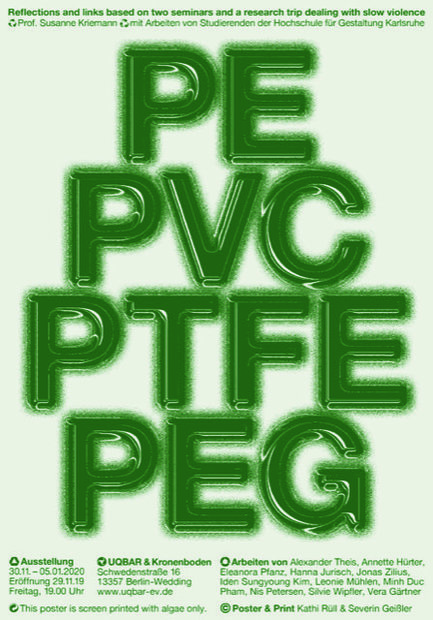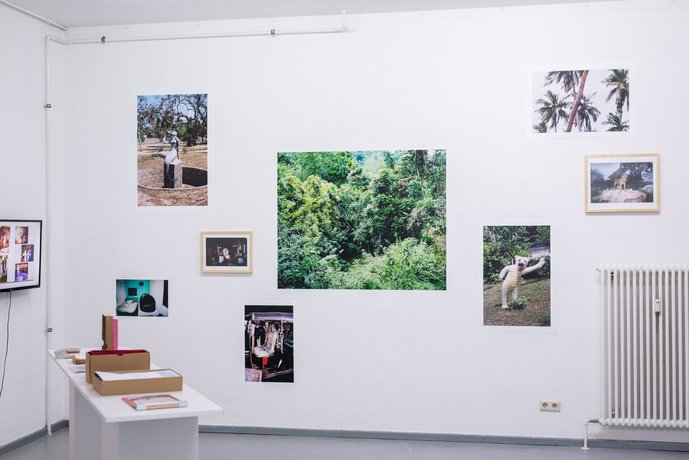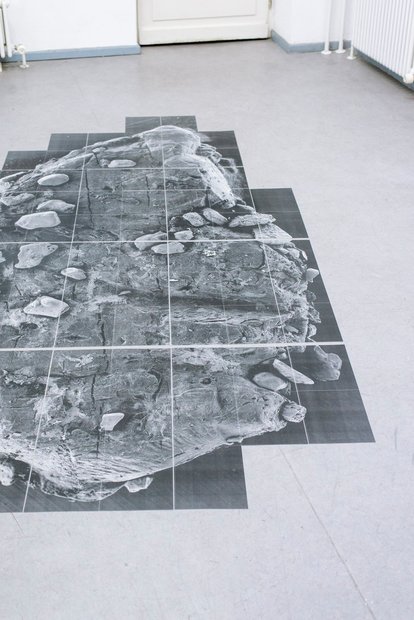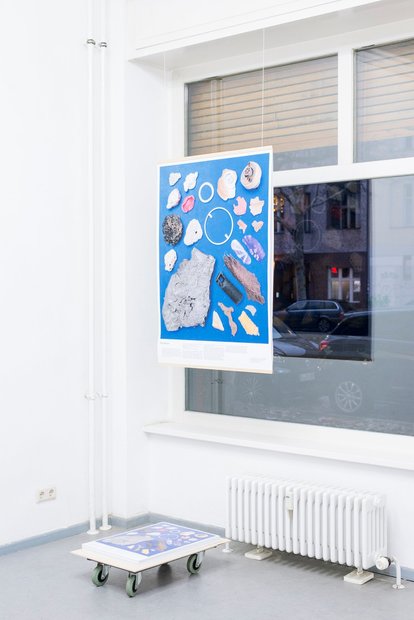PEPVCPTFEPEG Closing Event of the Exhibition in Berlin Saturday, 11.01.2020, 5–7pm // exhibition opens at 3pm // uqbar and Kronenboden, Schwedenstraße 16, 13357 Berlin-Wedding
© Severin Geißler und Kathrin Rüll
At the end of the HfG exhibition PEPVCPTFEPEG - Reflections and links based on two seminars and a research trip, dealing with slow violence in Berlin students and teachers invite to the closing event on January 11 in uqbar and Kronenboden (Berlin).
In the manner of a chemical compound, PEPVCPTFEPEG , combines the polymer structures of PE, PVC, PTFE, PEG to one monstrous string of various plastics. In current debate, the discussion focuses on the long-term effects of microplastics, that is on the small particles into which plastic disaggregates. Plastics, as (semi-)synthetic organic compounds were originally developed because of their ‘plasticity.’ They are specifically malleable and can be molded into almost any possible object. Yet, this is also the reason that plastic is a very unstable material—plastic lives. Exposed to the weather, and especially in the open ocean, it breaks down quickly into ‘mermaid tears.’ The term captures the dilemma of the situation of finding millions of these colorful, small pearls on the beaches.
It is the hardly visible and long-term effects on the ecosystem of such processes as microplastics that Ron Nixon subsumes under the term of ‘slow violence.’ Only rather recently, microplastics has surfaced in the public, but quickly has become a much-debated concern. In two seminars of the Karlsruhe University of Arts and Design (HfG), as well as on a research trip to Sri Lanka, led by Prof. Susanne Kriemann and Friederike Schäfer, a group of students developed process-based works for recording these issues. They analyzed and documented moments of ‘slow violence’ in the landscapes of the South Asian island, while taking into consideration their own relations and actions to plastics on their very daily routines. In their research, they furthermore discovered that plastic not only breaks down, poisoning our water and the animals that depend on it, but that it is also the basis for new hybrid-forms that develop in and with the plastic—it lives.
The exhibition PEPVCPTFEPEG at uqbar and Kronenboden is the result of a collective research. For their work, each student developed an individual approach to conceive and/or capture this entropic environmental condition. The works presented here, are to be seen as reflections on the pending task of finding apt methods for a documentation of the long-term effects of ‘slow violence’—and our own entanglement.
Students
Alexander Theis, Annette Hürter, Eleanora Pfanz, Hanna Jurisch, Jonas Zilius, Iden Sungyoung Kim, Leonie Mühlen, Minh Duc Pham, Nis Petersen, Silvie Wipfler, Vera Gärtner
A project by the Karlsruhe University of Arts and Design, Department Media Art/ Photography (Prof. Susanne Kriemann with Friederike Schäfer). In collaboration with uqbar and Kronenboden.
Diesen Beitrag Teilen auf
{"/en/aktuelles/": {"style": "aktuelles", "label": "News", "children": {"container_attrs": "data-ng-cloak data-hfg-news-filter", "style": "blackout", "/en/aktuelles/": {"style": "news", "label": "All"}, "/en/aktuelles/ausstellung": {"style": "exhibition", "label": "Exhibition"}, "/en/aktuelles/projekt": {"style": "project", "label": "Project"}, "/en/aktuelles/veranstaltung": {"style": "event", "label": "Event"}, "/en/aktuelles/kooperation": {"style": "cooperation", "label": "Cooperation"}, "/en/aktuelles/meldung": {"style": "announcement", "label": "Announcement"}, "/en/aktuelles/offene-stellen": {"style": "job-vacancies", "label": "Job vacancies"}, "/en/aktuelles/aktuelle-publikationen": {"style": "new-publications", "label": "New publications"}}}, "/en/hochschule/": {"label": "About us", "children": {"/en/hochschule/mission/": {"label": "Mission statement", "hidden": "true"}, "/en/hochschule/geschichte/": {"label": "History"}, "/en/hochschule/lehre/": {"label": "Teaching"}, "/en/hochschule/organe-und-gremien/": {"label": "Boards and committees", "children": {"/en/hochschule/organe-und-gremien/rektorat/": {"label": "Rectorate"}, "/en/hochschule/organe-und-gremien/senat/": {"label": "Senate"}, "/en/hochschule/organe-und-gremien/hochschulrat/": {"label": "University Council"}, "/en/hochschule/organe-und-gremien/gleichstellungsbeauftragte/": {"label": "Gender Equality Representative"}, "/en/hochschule/organe-und-gremien/behindertenbeauftragter/": {"label": "Representative for the Disabled"}, "/en/hochschule/organe-und-gremien/personalrat/": {"label": "Staff Council"}, "/en/hochschule/organe-und-gremien/asta/": {"label": "Students\u2019 Union"}, "/en/hochschule/organe-und-gremien/fachgruppensprecherinnen/": {"label": "Department Spokespersons"}}}, "/en/hochschule/verwaltung/": {"label": "Administration"}, "/en/hochschule/bekanntmachungen-des-rektorats/": {"label": "Announcements from the rectorate"}, "/en/hochschule/kooperationen/": {"label": "Cooperations"}, "/en/hochschule/zentrale-einrichtungen/": {"label": "Central facilities", "children": {"/en/hochschule/zentrale-einrichtungen/bibliothek": {"label": "Library"}, "/en/hochschule/zentrale-einrichtungen/studios-und-werkstaetten": {"label": "Studios and workshops"}, "/en/hochschule/zentrale-einrichtungen/ausleihe": {"label": "Loans"}}}, "/en/hochschule/foerdergesellschaft/": {"label": "Development fund"}, "/en/hochschule/presse-oeffentlichkeitsarbeit/": {"label": "Press / Public relations"}, "/en/hochschule/publikationen/": {"label": "Publications", "children": {"/en/hochschule/publikationen/jahresberichte/": {"label": "Annual Reports"}, "/en/hochschule/publikationen/informationsbroschueren/": {"label": "Information brochures"}, "/en/hochschule/publikationen/munitionsfabrik/": {"label": "Munitionsfabrik"}, "/en/hochschule/publikationen/edition-76135/": {"label": "Edition 76135"}, "/en/hochschule/publikationen/neue-folge/": {"label": "Neue Folge"}, "/en/hochschule/publikationen/reihe-hfg-forschung/": {"label": "Reihe HfG Forschung"}, "/en/hochschule/publikationen/massnahme/": {"label": "Ma\u00dfnahme"}, "/en/hochschule/publikationen/schriftenreihe-der-hfg-bei-cantz/": {"label": "cantz book series"}, "/en/hochschule/publikationen/weitere-publikationen/": {"label": "Various publications"}}}, "/en/hochschule/downloads/": {"label": "Downloads"}, "/en/hochschule/informationen-fuer-hochschulangehoerige/": {"label": "Information for University Staff and Students"}, "/en/hochschule/stellen/": {"label": "Job vacancies"}}}, "/en/studium/": {"label": "Studies", "children": {"/en/studium/fachgruppen-und-studiengange/": {"label": "Departments and courses of study", "children": {"/en/studium/fachgruppen-und-studiengange/ausstellungsdesign-und-szenografie/": {"label": "Exhibition Design and Scenography"}, "/en/studium/fachgruppen-und-studiengange/kommunikationsdesign/": {"label": "Communication Design"}, "/en/studium/fachgruppen-und-studiengange/produktdesign/": {"label": "Product Design"}, "/en/studium/fachgruppen-und-studiengange/kunstwissenschaft-und-medienphilosophie/": {"label": "Art Research and Media Philosophy"}, "/en/studium/fachgruppen-und-studiengange/medienkunst/": {"label": "Media Art"}}}, "/en/studium/studieninteressierte/": {"label": "Prospective Students"}, "/en/studium/bewerbung/": {"label": "Application", "children": {"/en/studium/bewerbung/studienberatung-und-mappenberatung/": {"label": "Study and portfolio advice"}, "/en/studium/bewerbung/bewerbungsverfahren/": {"label": "Application procedure"}, "/en/studium/bewerbung/zulassung-und-eignungspruefung/": {"label": "Admission requirements and aptitude examination"}, "/en/studium/bewerbung/immatrikulation/": {"label": "Enrollment"}, "/en/studium/bewerbung/gasthoererinnen/": {"label": "Auditors", "children": {"/studium/bewerbung/gasthoererinnen/gasthoererinnen/": {"label": "Auditors"}, "/studium/bewerbung/gasthoererinnen/hoererinnen-vom-kit/": {"label": "Auditors from KIT"}}}, "/en/studium/bewerbung/informationen-fuer-internationale-bewerberinnen/": {"label": "Information for international applicants"}}}, "/en/studium/preise-und-stipendien/": {"label": "Prizes and Scholarships"}, "/en/studium/wohnen-und-leben-in-karlsruhe/": {"label": "Living in Karlsruhe"}, "/en/studium/downloads/": {"label": "Downloads"}, "/en/studium/kontakt/": {"label": "Contact"}}}, "/en/vorlesungsverzeichnis/": {"label": "University Calendar"}, "/en/forschung-und-entwicklung/": {"label": "Research and Development", "children": {"/en/forschung-und-entwicklung/forschungsfoerderung/": {"label": "Research Funding"}, "/en/forschung-und-entwicklung/forschungsprojekte/": {"label": "Research Projects"}, "/en/forschung-und-entwicklung/promovieren/": {"label": "Doctorates"}, "/en/forschung-und-entwicklung/promotionsprojekte/": {"label": "Doctoral Projects"}, "/en/forschung-und-entwicklung/open-drafts/": {"label": "Open Drafts"}, "/forschung-und-entwicklung/orc/": {"label": "Open Resource Center", "children": {"/forschung-und-entwicklung/orc/auda/": {"label": "AuDA"}}}}}, "/en/international/": {"label": "International", "children": {"/en/international/incomings": {"label": "Incomings", "children": {"/en/international/incomings/informationen-fuer-internationale-bewerberinnen/": {"label": "Information for international applicants"}, "/en/international/incomings/erasmus/": {"label": "Exchange Students (Erasmus+/Overseas)"}, "/en/international/incomings/praktische-informationen-fuer-internationale-studierende/": {"label": "Practical information for international students"}, "/en/international/incomings/freemover/": {"label": "Free Movers"}}}, "/en/international/outgoings/": {"label": "Outgoings", "children": {"/en/international/outgoings/wege-ins-ausland/": {"label": "Going abroad"}, "/en/international/outgoings/foerdermoeglichkeiten/": {"label": "Funding opportunities", "children": {"/en/international/outgoings/foerdermoeglichkeiten/erasmus/": {"label": "Erasmus+"}, "/en/international/outgoings/foerdermoeglichkeiten/promos/": {"label": "PROMOS"}, "/en/international/outgoings/foerdermoeglichkeiten/baden-wuerttemberg-stipendium/": {"label": "Baden-W\u00fcrttemberg Scholarship"}, "/en/international/outgoings/foerdermoeglichkeiten/freemover/": {"label": "Free movers"}}}, "/en/international/outgoings/partnerhochschulen/": {"label": "Partner universities", "children": {"/en/international/outgoings/partnerhochschulen/erasmus-partnerhochschulen/": {"label": "Erasmus partner universities"}, "/en/international/outgoings/partnerhochschulen/internationale-austauschprogramme/": {"label": "International exchange programs"}}}, "/en/international/outgoings/erfahrungsberichte": {"label": "Student Experiences"}}}, "/en/international/dokumente/": {"label": "Documents"}, "/en/international/strategie/": {"label": "Strategy"}}}, "/en/kontakt/": {"label": "Contact"}, "/en/service/": {"label": "Service", "children": {"/en/service/allgemeines/": {"label": "General Information"}, "/en/service/health-and-safety/": {"label": "Health and Safety"}, "/en/service/studieninteressierte/": {"label": "Prospective Students"}, "/en/service/studierende/": {"label": "Students"}, "/en/service/beschaeftigte/": {"label": "Employees"}, "/en/service/partner-und-alumni/": {"label": "Partners and Alumni"}}}, "/en/personen/": {"label": "People"}, "/en/suche/": {"label": "Search"}, "/en/studierenden-projekte/": {"label": "Student projects"}, "https://zkm.de/en": {"label": "ZKM"}, "/en/mikro-sites/": {"label": "Microsites"}, "/en/publikationsplattform/": {"label": "Publikationsplattform"}}







